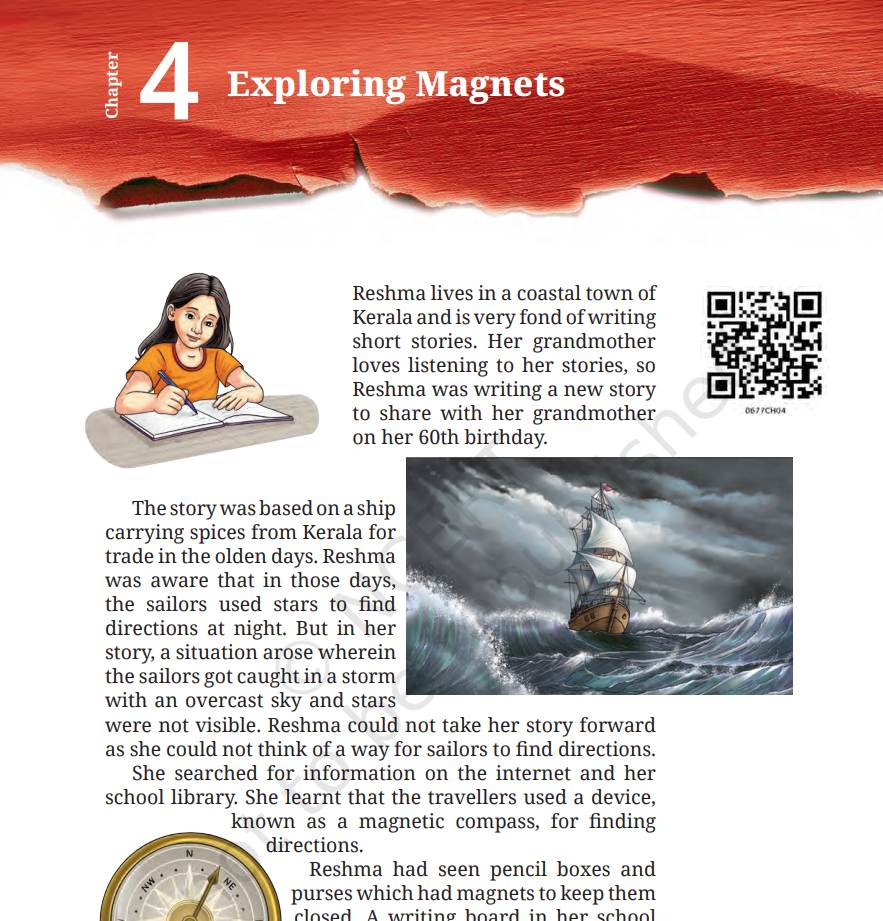
NCERT Exploring Magnets Class 6 Questions and Answers Solved Worksheet | Curiosity | Chapter 4 is essential for young learners to build a strong foundation in the subject, and NCERT Class 6 Science Question Answer Solved Worksheet. Understanding the chapter thoroughly helps students grasp key concepts, improve comprehension, and perform well in exams.
In this post, NCERT Exploring Magnets Class 6 Questions and Answers Solved | Chapter 4 | Curiosity, we provide detailed NCERT Solutions for Class 6 science to make learning easier and more effective. Whether you are a student looking for well-explained solutions or a parent guiding your child, this guide will be a helpful resource for mastering the chapter with confidence. Also, we include NCERT Solutions for Class 6 Science Chapter 4 Question Answer pdf Meaning in Bengali.
Exploring Magnets NCERT Class 6th Science Chapter 4 Question Answer.
Table of Contents
NCERT Exploring Magnets Class 6 Questions and Answers | Chapter 4 | Curiosity | Must Read
1. Do magnets stick to objects made of certain materials only? (page- 62)
Answer: Yes, magnets stick only to objects made of certain materials, mainly ferromagnetic materials like iron, nickel, cobalt etc.
2. Record your observations in Table 4.1. (page- 63)
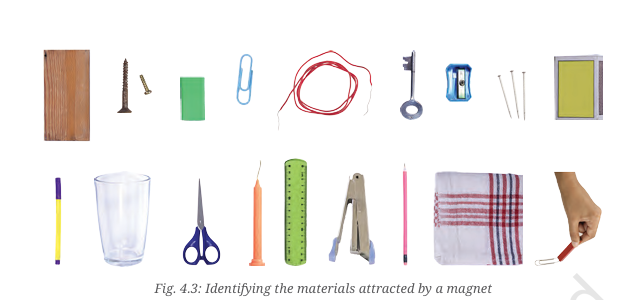
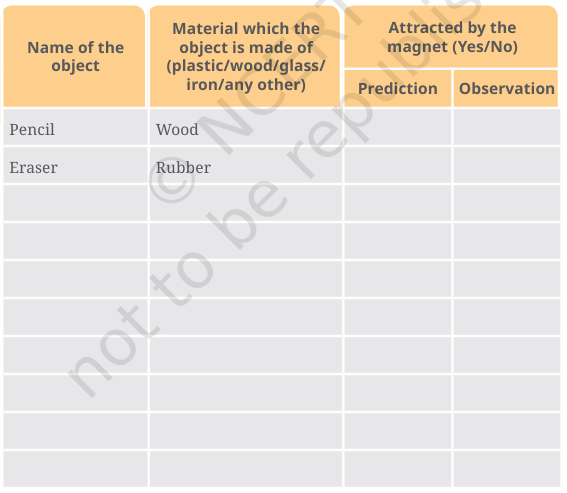
Answer: Now fill the table from the above image.
| Name of The Objct | Material which the object is made of (plastic/wood/glass/iron/any other) | Attracted by the magnet (Yes/No) |
|---|---|---|
| Pencil | Wood | Prediction: No Observation: No |
| Eraser | Rubber | Prediction: No Observation: No |
| Screw | Iron | Prediction: Yes Observation: Yes |
| Sharpener | Plastic + Iron blade | Prediction: Yes Observation: Yes |
| Paper Clip | Iron | Prediction: Yes Observation: Yes |
| Nail | Iron | Prediction: Yes Observation: Yes |
| Coin | Metal | Prediction: Yes Observation: Yes |
| Plastic Scale | Plastic | Prediction: No Observation: No |
| Glass tumbler | Glass | Prediction: No Observation: No |
| Steel key | Iron/steel | Name of the Object |
| Woolen cloth | Fabric | Prediction: No Observation: No |
| Stapler | Metal + Plastic | Prediction: Yes Observation: Yes |
| Candle | Wax | Prediction: No Observation: No |
| Book | Paper | Prediction: No Observation: No |
| Copper Wire | Copper | Prediction: No Observation: No |
| Scissors | Steel | Prediction: Yes Observation: Yes |
| Plastic pen | Plastic | Prediction: No Observation: No |
3. Do all parts of a magnet attract magnetic materials equally? (Page- 64)
Answer: No, all parts of a magnet do not attract magnetic materials equally. Because the end parts of magnets are called poles, where the magnetic fields are strongest. And the middle part of any magnet has weaker magnetic force.
4. Can we find a magnet with a single pole? (Page- 65)
Answer: No, we can not find a magnet with a single pole. Because every magnet must have two poles (north and south).
5. What direction does this line indicate along which the magnet rests ? How can we find it out? (Page- 65)
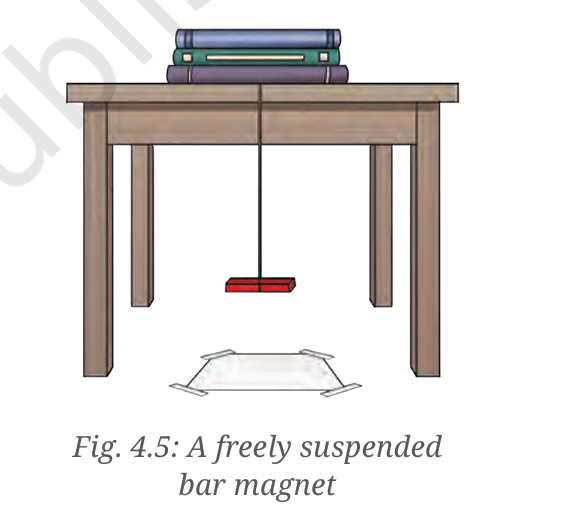
Answer: The direction is the North- South direction. If you suspend a bar magnet with a thread tied to the middle of the magnet, then a freely suspended bar magnet always aligns itself along the Earth’s magnetic field.
How can you find out: You can use this method.
- Tie a bar magnet with a thread and suspend it freely (as shown in the image).
- Let it swing and settle.
- After a few moments, it will stop and point in a particular direction.
- Use a compass to confirm—the end pointing toward the geographic north is the North Pole of the magnet.
Note: This principle is the same for making a magnetic compass.
Exploring Magnets Class 6 Questions and Answers
6. How can we make our own magnetic compass? (Page- 66)
Answer: To create your own magnetic compass, you need some basic knowledge of Earth’s magnetic field and some materials:
- A sewing needle or small pin
- A bar magnet (or any strong magnet)
- A bowl of water
- A small piece of cork, foam, or leaf
Steps:
- Rub one end of the needle with a magnet about 20–30 times in the same direction.
(This makes the needle magnetic.) - Stick the needle through a piece of cork. It should float easily on water.
- Place the cork/foam/leaf with the needle on a still bowl of water. Make sure it floats freely and doesn’t touch the sides.
- The needle will slowly turn and come to rest pointing in the north-south direction.
7. What happens when we bring two magnets closer to each other? (Page- 67)
Answer: When two magnets are brought close to each other, they either attract or repel depending on the poles facing each other. If like poles (north-north or south-south) are brought together, they repel each other. If unlike poles (north-south) face each other, they attract. This happens due to the interaction of their magnetic fields.
8. The compass needle is also a magnet. Will it show the same behavior if a magnet is brought closer to it? (Page- 69)
Answer: Yes, the compass needle is a small magnet, so it will show the same behavior when another magnet is brought close to it.
9. Suppose we place a piece of wood between the compass needle and the magnet. Will this affect the deflection of the compass needle? (Page- 70)
Answer: No, if we place a piece of wood between the compass needle and the magnet, it will not affect the deflection of the compass needle. Because wood is a non-magnetic material and does not block or interfere with magnetic fields.
10. Fill this table? (Page- 71) (Exploring Magnets Class 6 Questions and Answers)
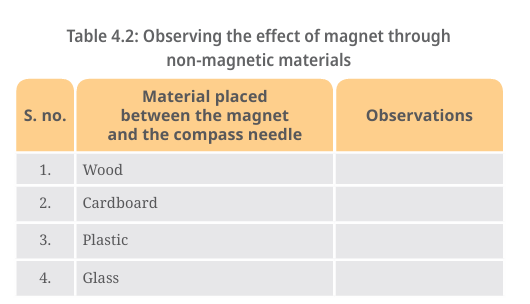
Answer:
| S. No | Material placed between the magnet and the compass needle | Observations |
|---|---|---|
| 1. | Wood | Needle gets deflected |
| 2. | Cardboard | Needle gets deflected |
| 3. | Plastic | Needle gets deflected |
| 4. | Glass | Needle gets deflected |
11. Magnets can move some objects without touching them! Is that not amazing? (Page- 71)
Answer: Yes, it is really amazing. Magnets can move certain objects, like iron nails or paper clips, without even touching them—simply by using their invisible magnetic force.
Exploring Magnets Class 6 Questions and Answers
Chapter Wise NCERT Solutions for Class 6 Science Curiosity
| Chapter Name | Solution Link |
|---|---|
| 1. NCERT Solutions for Class 6 science Chapter 1 (The wonderful world of science) | Visit Here |
| 2. NCERT Solutions for Class 6 science Chapter 2 (Diversity in the living world) | Visit Here |
| 3. NCERT Solutions for Class 6 science Chapter 3 (Mindful Eating) | Visit Here |
| 4. NCERT Solutions for Class 6 science Chapter 4 (Exploring Magnets) | Visit Here |
| 5. NCERT Solutions for Class 6 science Chapter 5 | Coming Soon |
NCERT Let us enhance our learning | Chapter 4 | Curiosity | Must Read (page: 74-77)
1. Fill in the blanks (Exploring Magnets Class 6 Questions and Answers)
(i) Unlike poles of two magnets ______________ each other, whereas like poles ____________ each other.
Answer: Unlike poles of two magnets attract each other, whereas like poles repel each other.
(ii) The materials that are attracted towards a magnet are called ______________
Answer: The materials that are attracted towards a magnet are called magnetic materials.
(iii) The needle of a magnetic compass rests along the ____________ direction.
Answer: The needle of a magnetic compass rests along the north-south direction.
(iv) A magnet always has _______________ poles.
Answer: A magnet always has two poles.
2. State whether the following statements are True (T) or False (F) (Exploring Magnets Class 6 Questions and Answers)
(i) A magnet can be broken into pieces to obtain a single pole. [ False ]
(ii) Similar poles of a magnet repel each other. [ True ]
(iii) Iron filings mostly stick in the middle of a bar magnet when it is brought near them. [ False ]
(iv) A freely suspended bar magnet always aligns with the north-south direction. [ True ]
3. Fill in the column (Exploring Magnets Class 6 Questions and Answers)
Column I shows different positions in which one pole of a magnet is placed near that of the other. Column II indicates the resulting interaction between them for different situations. Fill in the blanks.
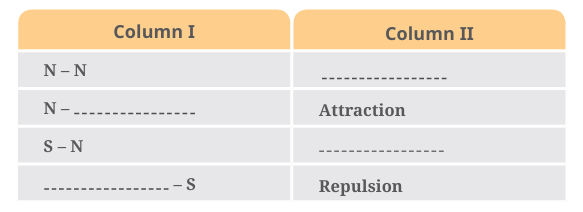
Answer:
| Column I | Column II |
|---|---|
| N-N | Repulsion |
| N-S | Attraction |
| S-N | Attraction |
| S-S | Repulsion |
4. Atharv performed an experiment in which he took a bar magnet and rolled it over a heap of steel U-clips. According to you, which of the options given in table 4.3 is likely to be his observation?
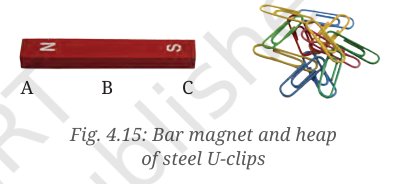
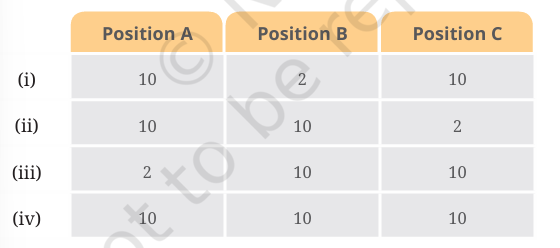
Answer: Option (i) will be matched. Because most U-clips stick to the ends (A and C), and only a few stick to the middle (B).
| Options | Position A | Position B | Position C |
|---|---|---|---|
| (i) | 10 | 2 | 10 ✅ Strong at poles, weak at center |
| (ii) | 10 | 10 | 2 ❌ A should also be strong |
| (iii) | 2 | 10 | 10 ❌ A is too low |
| (iv) | 10 | 10 | 10 ❌ B should be weaker |
5. Reshma bought three identical metal bars from the market. Out of these bars, two were magnets and one was just a piece of iron. How will she identify which two amongst the three could be magnets (without using any other material)?
Answer: Reshma can identify the two magnets by using only the three metal bars through this simple method:
Reshma can find the two magnets by checking how the bars attract each other. She should bring the bars close one by one. The two bars that attract each other from the middle are magnets. The one that only gets attracted but doesn’t attract others is the iron bar.
6. You are given a magnet which does not have the poles marked. How can you find its poles with the help of another magnet which has its poles marked?
Answer: Take the magnet with marked poles and bring its north pole near one end of the unmarked magnet. If they repel, that end is also a north pole. If they attract, that end is a south pole.
7. A bar magnet has no marking to indicate its poles. How would you find out near which end its North pole is located without using another magnet?
Answer: To find the North pole of an unmarked bar magnet without using another magnet, you can use the hanging method.
8. If the earth is itself a magnet, can you guess the poles of earth’s magnet by looking at the direction of the magnetic compass?
Answer: Yes, if the Earth is a magnet, we can guess its magnetic poles by looking at the direction of a magnetic compass. The north pole of a compass needle always points towards the geographic north. Since opposite poles attract, the north pole of the compass needle is attracted to the Earth’s magnetic south pole.
9. While a mechanic was repairing a gadget using a screw driver, the steel screws kept falling down. Suggest a way to solve the problem of the mechanic on the basis of what you have learnt in this chapter.
Answer: To solve the mechanic’s problem, the screwdriver can be magnetised. A magnetised screwdriver will attract the steel screws, makes it easier to hold and fix them without falling.
10. Two ring magnets X and Y are arranged as shown in Fig. 4.16. It is observed that the magnet X does not move down further. What could be the possible reason? Suggest a way to bring the magnet X in contact with magnet Y, without pushing either of the magnets.
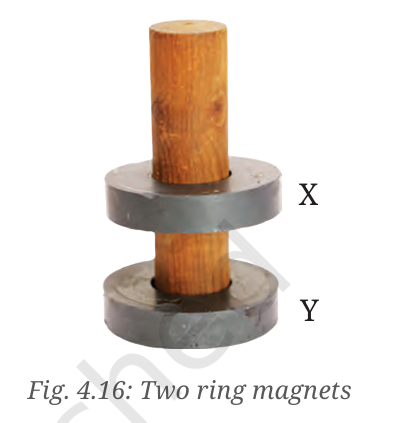
Answer: magnet X does not move down to touch magnet Y because the like poles of both magnets are facing each other, causing a repulsive force. This repulsion pushes magnet X upward and prevents it from coming in contact with magnet Y.
Possible Reason: Both magnets have the same poles facing each other (e.g., north-north or south-south), and like poles repel.
Solution: To bring magnet X in contact with magnet Y without pushing, simply remove one magnet (X or Y), flip it upside down, and place it back. Now the opposite poles will face each other, and due to attraction, magnet X will move down and stick to magnet Y.
11. Three magnets are arranged on a table in the form of the shape shown in Fig. 4.17. What is the polarity, N or S, at the ends 1, 2, 3, 4 and 6 of the magnets? Polarity of one end (5) is given for you.
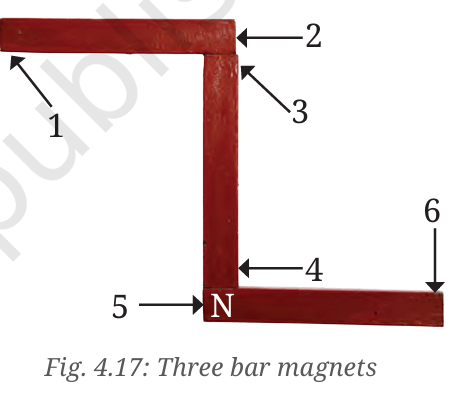
Answer: The polarity at end 5 is given as North (N). We can use this rule that opposite poles attract and like poles repel, we can deduce the polarity of the remaining ends.
Rules: (i) Each bar magnet has two poles: North (N) and South (S).
(ii) If one end is North, the opposite end is South.
Polarity Find:
- End 5 is N, so the oposite of end bar 6 must be South pole (S)
- End 5 is N. And it attract the point 4. So, it must be South (S)
- Now end 4 is S, so end 3 must be North (N)
- End 3 attract end 2. So end 2 must be South (S)
- Now end 2 is South, then end 1 must be North (N)
| End No | Polarity |
|---|---|
| 1 | N |
| 2 | S |
| 3 | N |
| 4 | S |
| 5 | N |
| 6 | S |
Chapter Wise NCERT Solutions for Class 6 Science Curiosity
| Chapter Name | Solution Link |
|---|---|
| 1. NCERT Solutions for Class 6 science Chapter 1 (The wonderful world of science) | Visit Here |
| 2. NCERT Solutions for Class 6 science Chapter 2 (Diversity in the living world) | Visit Here |
| 3. NCERT Solutions for Class 6 science Chapter 3 (Mindful Eating) | Visit Here |
| 4. NCERT Solutions for Class 6 science Chapter 4 (Exploring Magnets) | Visit Here |
| 5. NCERT Solutions for Class 6 science Chapter 5 | Coming Soon |
